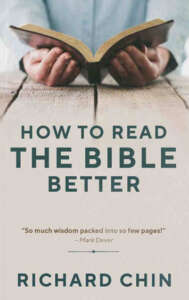Here’s something you should have been asked: do you know how to read the Bible better?
Richard Chin, National Director of the Australian Fellowship of Evangelical Students, (a mouthful title for a big role) brings the wisdom his team has gained from decades of getting university students into the Bible, into a new book How to read the Bible better.
Their task has been to get students – often studying recent scientific and other knowledge gained within the last few years – to take seriously a book rapidly approaching 2000 years old (at a minumum). It is almost embarrassing for me to admit that it dawned on me one day as a university student that the Bible was something you could study seriously, and that you could think deeply about Christianity.
Chin explains simply that this book, the Bible, is different.
- This book is written by God who determines its meaning. Whatever you think about reader-response theory – the idea that texts are constructed by the reader – this book has the author of meaning, all meaning, behind it.
- It’s also written by people who left their marks on it. “Peter does not write like Paul, who does not write like John.”
- They did not write for us, but for specific audiences. We need to take notice so a flat reading is ruled out.
- It all points to Jesus (Not a spoiler, you knew that) but was written for us.
God could talk directly to us if he chose, says Chin.
“But he does not promise to speak directly to us like this. God chose to speak directly to Balaam through a donkey in Numbers 22, but he never promised to keep doing so.
“Likewise, God spoke directly to King Belshazzar by writing on a wall in Daniel 5. But my guess is that you don’t expect God to speak to you today through donkeys or graffiti, because he doesn’t promise to do so, even though he can!”
Here’s how Chin asks students to approach the Bible’s text:
Carefully observe the text, ask it questions and try to find answers, work out the structure, observe the genre, and make a careful distinction between descriptive and prescriptive passages.
“For example, the apostles were sent out to heal the sick, raise the dead, cleanse lepers, and cast out demons (Matt 10:8). This describes their specific mission, but it does not prescribe what God intends for every believer. However, later in the same chapter, Jesus goes on to say: ‘Whoever loves father and mother more than me is not worthy of me’ (v. 37 ff.). This is clearly a comment for every believer.”
This is a distinctively evangelical way of reading the Bible, avoiding allegory or assuming you can take verses or fragments on their own – the lucky dip way of reading scripture.
Sometimes the immediate context of a verse makes it clear. Chin gives the example of Romans 14:9 which both says that Christ died and explains why: “For to this end Christ died and lived again, that he might be Lord both of the dead and of the living.”
Sometimes something is explained somewhere else in a book – the example of faith used in Colossians 2, but defined in Colossians 4.
And then there is a weightier subject of how Scripture should be used to interpret Scripture.
How to Read the Bible Better introduces the two key ways of analysing the Bible – biblical theology, which considers the Bible as one big story, and Systematic theology, which looks at the doctrines we derive from it – and as chin emphasises how they fit together.
Questions for Biblical theology might include: “How does this fit in the big story” “What do we learn about God’s way of doing things in in this episode”
Qustions that Systematic theology might ask: “how do Paul and James use the word “faith” – and how can we integrate their differences?
And what should be the outcome of all this careful Bible study? Joy. Joy in loving and serving God and neighbour because we have been convinced by the book we have been studying, through the Spirit which leads us to take it in.
 How to Read the Bible Better
How to Read the Bible Better
Richard Chin
Matthias Media
Available from Koorong
.
Email This Story
Why not send this to a friend?


